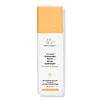What's inside
What's inside
 Key Ingredients
Key Ingredients

 Benefits
Benefits

 Concerns
Concerns

 Ingredients Side-by-side
Ingredients Side-by-side

Water
Skin ConditioningPropanediol
SolventSodium Ascorbyl Phosphate
AntioxidantGlycerin
HumectantIsodecyl Neopentanoate
EmollientSqualane
EmollientNeopentyl Glycol Diheptanoate
EmollientC9-12 Alkane
SolventSodium Polyacryloyldimethyl Taurate
Emulsion StabilisingAscorbyl Glucoside
AntioxidantCoco-Caprylate/Caprate
EmollientSclerocarya Birrea Seed Oil
HumectantPullulan
Sclerotium Gum
Emulsion StabilisingDiglucosyl Gallic Acid
Sorbitan Sesquiisostearate
EmulsifyingGlutathione
Sodium Hyaluronate
HumectantSorbeth-30 Tetraisostearate
EmulsifyingDipropylene Glycol
HumectantPhloretin
AntioxidantSodium Citrate
BufferingSodium Metabisulfite
AntioxidantPPG-8-Ceteth-20
EmulsifyingGluconolactone
Skin ConditioningAcrylates/Beheneth-25 Methacrylate Copolymer
Citric Acid
BufferingTetrasodium Glutamate Diacetate
Silica
AbrasiveLecithin
EmollientXanthan Gum
EmulsifyingTocopheryl Acetate
AntioxidantSodium Hydroxide
BufferingPhenoxyethanol
PreservativeSodium Benzoate
MaskingChondrus Crispus Extract
Skin ConditioningWater, Propanediol, Sodium Ascorbyl Phosphate, Glycerin, Isodecyl Neopentanoate, Squalane, Neopentyl Glycol Diheptanoate, C9-12 Alkane, Sodium Polyacryloyldimethyl Taurate, Ascorbyl Glucoside, Coco-Caprylate/Caprate, Sclerocarya Birrea Seed Oil, Pullulan, Sclerotium Gum, Diglucosyl Gallic Acid, Sorbitan Sesquiisostearate, Glutathione, Sodium Hyaluronate, Sorbeth-30 Tetraisostearate, Dipropylene Glycol, Phloretin, Sodium Citrate, Sodium Metabisulfite, PPG-8-Ceteth-20, Gluconolactone, Acrylates/Beheneth-25 Methacrylate Copolymer, Citric Acid, Tetrasodium Glutamate Diacetate, Silica, Lecithin, Xanthan Gum, Tocopheryl Acetate, Sodium Hydroxide, Phenoxyethanol, Sodium Benzoate, Chondrus Crispus Extract
Aloe Barbadensis Leaf Juice
Skin ConditioningAscorbic Acid
AntioxidantVitis Vinifera Juice
AntioxidantGlycerin
HumectantPyrus Malus Juice
Skin ConditioningSodium Hyaluronate
HumectantTocopherol
AntioxidantFerulic Acid
AntimicrobialLavandula Angustifolia Oil
MaskingLavandula Hybrida Oil
EmollientSalvia Hispanica Seed Extract
EmollientHydrolyzed Viola Tricolor Extract
Skin ProtectingCocos Nucifera Fruit Extract
EmollientLactobacillus
Skin ConditioningLactobacillus Ferment
Skin ConditioningLactobacillus Ferment Lysate
Skin ConditioningGlyceryl Caprylate
EmollientPolyglyceryl-3 Cocoate
EmulsifyingPolyglyceryl-4 Caprate
EmulsifyingPolyglyceryl-6 Caprylate
EmulsifyingPolyglyceryl-6 Ricinoleate
EmulsifyingLysolecithin
EmulsifyingSclerotium Gum
Emulsion StabilisingXanthan Gum
EmulsifyingCaesalpinia Spinosa Gum
Skin ConditioningPullulan
Capryloyl Glycerin
Diheptyl Succinate
EmollientCaprylhydroxamic Acid
Sodium Phytate
Triethyl Citrate
MaskingSilica
AbrasiveCitrus Aurantium Dulcis Flower Oil
AstringentAloe Barbadensis Leaf Juice, Ascorbic Acid, Vitis Vinifera Juice, Glycerin, Pyrus Malus Juice, Sodium Hyaluronate, Tocopherol, Ferulic Acid, Lavandula Angustifolia Oil, Lavandula Hybrida Oil, Salvia Hispanica Seed Extract, Hydrolyzed Viola Tricolor Extract, Cocos Nucifera Fruit Extract, Lactobacillus, Lactobacillus Ferment, Lactobacillus Ferment Lysate, Glyceryl Caprylate, Polyglyceryl-3 Cocoate, Polyglyceryl-4 Caprate, Polyglyceryl-6 Caprylate, Polyglyceryl-6 Ricinoleate, Lysolecithin, Sclerotium Gum, Xanthan Gum, Caesalpinia Spinosa Gum, Pullulan, Capryloyl Glycerin, Diheptyl Succinate, Caprylhydroxamic Acid, Sodium Phytate, Triethyl Citrate, Silica, Citrus Aurantium Dulcis Flower Oil
 Reviews
Reviews

Ingredients Explained
These ingredients are found in both products.
Ingredients higher up in an ingredient list are typically present in a larger amount.
Glycerin is already naturally found in your skin. It helps moisturize and protect your skin.
A study from 2016 found glycerin to be more effective as a humectant than AHAs and hyaluronic acid.
As a humectant, it helps the skin stay hydrated by pulling moisture to your skin. The low molecular weight of glycerin allows it to pull moisture into the deeper layers of your skin.
Hydrated skin improves your skin barrier; Your skin barrier helps protect against irritants and bacteria.
Glycerin has also been found to have antimicrobial and antiviral properties. Due to these properties, glycerin is often used in wound and burn treatments.
In cosmetics, glycerin is usually derived from plants such as soybean or palm. However, it can also be sourced from animals, such as tallow or animal fat.
This ingredient is organic, colorless, odorless, and non-toxic.
Glycerin is the name for this ingredient in American English. British English uses Glycerol/Glycerine.
Learn more about GlycerinPullulan is a low viscosity polysaccharide (a long chain carbohydrate) with binding and film forming properties when dissolved in water. It is used to create a "silicone-like" or silky feel in cosmetics without adding viscosity.
According to a manufacturer, this ingredient's ability to easily dissolves makes it a great carrier for active ingredients.
Due to it being edible and tasteless, you'll likely find this ingredient in breath freshener strips. This ingredient is produced from the starch of the fungus, Aureobasidium pullulans.
Pullulan is stable over a broad-range of pH.
Learn more about PullulanSclerotium Gum is a polysaccharide gum made by the fungus, Sclerotium rolfssii. It is similar to xanthan gum.
In cosmetics, Sclerotium Gum is used to thicken the texture and to help stabilize other ingredients.
As an emulsifier, Sclerotium Gum helps prevent ingredients from separating, such as water and oil.
Learn more about Sclerotium GumSilica, also known as silicon dioxide, is a naturally occurring mineral. It is used as a fine, spherical, and porous powder in cosmetics.
Though it has exfoliant properties, the function of silica varies depending on the product.
The unique structure of silica enhances the spreadability and adds smoothness, making it a great texture enhancer.
It is also used as an active carrier, emulsifier, and mattifier due to its ability to absorb excess oil.
In some products, tiny microneedles called spicules are made from silica or hydrolyzed sponge. When you rub them in, they lightly polish away dead skin layers and enhance the penetration of active ingredients.
Learn more about SilicaSodium Hyaluronate is hyaluronic acid's salt form. It is commonly derived from the sodium salt of hyaluronic acid.
Like hyaluronic acid, it is great at holding water and acts as a humectant. This makes it a great skin hydrating ingredient.
Sodium Hyaluronate is naturally occurring in our bodies and is mostly found in eye fluid and joints.
These are some other common types of Hyaluronic Acid:
Learn more about Sodium HyaluronateXanthan gum is used as a stabilizer and thickener within cosmetic products. It helps give products a sticky, thick feeling - preventing them from being too runny.
On the technical side of things, xanthan gum is a polysaccharide - a combination consisting of multiple sugar molecules bonded together.
Xanthan gum is a pretty common and great ingredient. It is a natural, non-toxic, non-irritating ingredient that is also commonly used in food products.
Learn more about Xanthan Gum